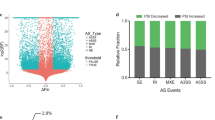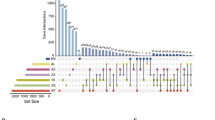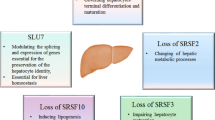Abstract
Overexpression of FGF-2 is associated with tumor recurrence and reduced survival after surgical resection of esophageal cancer, and these risks are reduced in tumors co-expressing the FGF antisense (FGF-AS) RNA. The aim of this study was to characterize the expression of alternatively spliced FGF-AS transcripts and encoded nudix-motif proteins in normal human tissues and in esophageal adenocarcinoma, and to correlate their expression with clinicopathologic findings and outcome. Three alternatively spliced FGF-AS transcripts encoding GFG/NUDT6 isoforms with distinct N termini were detected in various human tissues including esophageal adenocarcinoma. Expression of each isoform as a fusion protein with enhanced green fluorescent protein revealed differential subcellular trafficking: hGFGa is localized to mitochondria by an N-terminal targeting sequence (MTS), whereas hGFGb and hGFGc were localized in the cytoplasm and nucleus. Mutation/deletion analysis confirmed that the predicted MTS was necessary and sufficient for mitochondrial compartmentalization. The predominant FGF-AS mRNA expressed in esophageal tumors was splice variant b. GFG immunoreactivity was detected in the cytoplasm of all esophageal adenocarcinomas and in 88% of tumor cell nuclei. Although we found a trend towards reduced disease-free survival in patients with FGF-2 overexpressing esophageal adenocarcinomas, significantly worse disease-free survival was noted among patients whose tumors did not also overexpress the FGF-AS b isoform (p = 0.03). Tetracycline-inducible FGF-AS b expression in stably transfected human Seg-1 esophageal adenocarcinoma cells resulted in a significant suppression of steady state FGF-2 mRNA content and cell proliferation. Our data implicate the FGF-AS b isoform in modulation of FGF-2 expression and clinical outcome in esophageal adenocarcinoma.







Similar content being viewed by others
References
Rumpel CA, Powell SM, Moskaluk CA (1999) Mapping of genetic deletions on the long arm of chromosome 4 in human esophageal adenocarcinomas. Am J Pathol 154:1329–1334
Barnas C, Henn T, Stark M, Haas O, Romeo G, Montesano R, Hainaut P, Casson A (1999) Detection of genetic alterations in cancers of the esophagus and esophagogastric junction by comparative genomic hybridization: frequent involvement of chromosome 4q. Proceedings of the Am Assoc Cancer Res 1999, p 539
Powers CJ, McLesky SW, Wellstein A (2000) Fibroblast growth factors, their receptors and signaling. Endocr Relat Cancer 7:165–197
Huang A, Jin H, Wright JA (1994) Aberrant expression of basic fibroblast growth factor in nih-3t3 cells alters drug resistance and gene amplification potential. Exp Cell Res 213:336–339
Song S, Wientjes MG, Gan Y, Au JL-S (2000) Fibroblast growth factors: an epigenetic mechanism of broad spectrum resistance to anticancer drugs. Proc Natl Acad Sci (USA) 97:8658–8663
Murphy PR, Knee RS (1994) Identification and characterization of an antisense RNA transcript (gfg) from the basic fibroblast growth factor gene in human and rat cells. Mol Endocrinol 8:852–859
Knee R, Li AW, Murphy PR (1997) Characterization and tissue-specific expression of the rat basic fibroblast growth factor antisense mRNA and protein. Proc Natl Acad Sci USA 94:4943–4947
Li AW, Murphy PR (2000) Expression of alternatively spliced fgf-2 antisense RNA transcripts in the central nervous system: regulation of fgf-2 mRNA translation. Mol Cell Endocrinol 170:233–242
Asa SL, Ramyar L, Murphy PR, Li AW, Ezzat S (2001) The endogenous fibroblast growth factor-2 antisense gene product regulates pituitary cell growth and hormone production. Mol Endocrinol 15:589–599
Bessman MJ, Frick DN, O’Handley SF (1996) The mutt proteins or “nudix” hydrolases, a family of versatile, widely distributed, “housecleaning” enzymes. J Biol Chem 271:25059–25062
Barclay C, Li AW, Geldenhuys L, Baguma-Nibasheka M, Porter GA, Veugelers PJ, Murphy PR, Casson AG (2005) Basic fibroblast growth factor (fgf-2) overexpression is a risk factor for esophageal cancer recurrence and reduced survival, which is ameliorated by coexpression of the fgf-2 antisense gene. Clin Cancer Res 11:7683–7691
Sambrook J, Russell DW (2001) Molecular cloning: A laboratory manual. 3rd ed. Cold Spring Harbor Laboratory. Cold Spring Harbor, N.Y.
Strausberg RL, Feingold EA, Grouse LH, Derge JG, Klausner RD, Collins FS, Wagner L, Shenmen CM, Schuler GD, Altschul SF, Zeeberg B, Buetow KH, Schaefer CF, Bhat NK, Hopkins RF, Jordan H, Moore T, Max SI, Wang J, Hsieh F, Diatchenko L, Marusina K, Farmer AA, Rubin GM, Hong L, Stapleton M, Soares MB, Bonaldo MF, Casavant TL, Scheetz TE, Brownstein MJ, Usdin TB, Toshiyuki S, Carninci P, Prange C, Raha SS, Loquellano NA, Peters GJ, Abramson RD, Mullahy SJ, Bosak SA, McEwan PJ, McKernan KJ, Malek JA, Gunaratne PH, Richards S, Worley KC, Hale S, Garcia AM, Gay LJ, Hulyk SW, Villalon DK, Muzny DM, Sodergren EJ, Lu X, Gibbs RA, Fahey J, Helton E, Ketteman M, Madan A, Rodrigues S, Sanchez A, Whiting M, Young AC, Shevchenko Y, Bouffard GG, Blakesley RW, Touchman JW, Green ED, Dickson MC, Rodriguez AC, Grimwood J, Schmutz J, Myers RM, Butterfield YS, Krzywinski MI, Skalska U, Smailus DE, Schnerch A, Schein JE, Jones SJ, Marra MA (2002) Generation and initial analysis of more than 15,000 full-length human and mouse cDNA sequences. Proc Natl Acad Sci USA 99:16899–16903
Amann E, Brosius J, Ptashne M (1983) Vectors bearing a hybrid trp-lac promoter useful for regulated expression of cloned genes in Escherichia coli. Gene 25:167–178
Zhang SC, Wege C, Jeske H (2001) Movement proteins (bc1 and bv1) of abutilon mosaic geminivirus are cotransported in and between cells of sink but not of source leaves as detected by green fluorescent protein tagging. Virology 290:249–260
Bhatnagar SK, Bessman MJ (1988) Studies on the mutator gene, mutt of Escherichia coli. Molecular cloning of the gene, purification of the gene product, and identification of a novel nucleoside triphosphatase. J Biol Chem 263:8953–8957
Xu W, Gauss P, Shen J, Dunn CA, Bessman MJ (2002) The gene e.1 (nude.1) of t4 bacteriophage designates a new member of the nudix hydrolase superfamily active on flavin adenine dinucleotide, adenosine 5′-triphospho-5′-adenosine, and adp-ribose. J Biol Chem 277:23181–23185
Baguma-Nibasheka M, Li AW, Osman MS, Geldenhuys L, Casson AG, Too CK, Murphy PR (2005) Coexpression and regulation of the fgf-2 and fgf antisense genes in leukemic cells. Leuk Res 29:423–433
Casson AG, Zheng Z, Evans SC, Geldenhuys L, van Zanten SV, Veugelers PJ, Porter GA, Guernsey DL (2005) Cyclin d1 polymorphism (g870a) and risk for esophageal adenocarcinoma. Cancer 104:730–739
Casson AG, Tammemagi M, Eskandarian S, Redston M, McLaughlin J, Ozcelik H (1998) P53 alterations in oesophageal cancer: association with clinicopathological features, risk factors, and survival. Mol Pathol 51:71–79
Thierry-Mieg D, Thierry-Mieg J, Potdevin M, Sienkiewicz M (2004) Identification and functional annotation of cDNA-supported genes in higher organisms using Aceview. (hum nov 04 release). In: http://wwwacevieworg/
Emanuelsson O, Nielsen H, Brunak S, von Heijne G (2000) Predicting subcellular localization of proteins based on their n-terminal amino acid sequence. J Mol Biol 300:1005–1016
Nielsen H, Engelbrecht J, Brunak S, von Heijne G (1997) Identification of prokaryotic and eukaryotic signal peptides and prediction of their cleavage sites. Protein Eng 10:1–6
Bannai H, Tamada Y, Maruyama O, Nakai K, Miyano S (2002) Extensive feature detection of n-terminal protein sorting signals. Bioinformatics 18:298–305
Nair R, Rost B (2005) Mimicking cellular sorting improves prediction of subcellular localization. J Mol Biol 348:85–100
Claros MG, Vincens P (1996) Computational method to predict mitochondrially imported proteins and their targeting sequences. Eur J Biochem 241:779–786
Deleage G, Combet C, Blanchet C, Geourjon C (2001) Antheprot: an integrated protein sequence analysis software with client/server capabilities. Comput Biol Med 31:259–267
von Heijne G (1985) Signal sequences. The limits of variation. J Mol Biol 184:99–105
von Heijne G (1986) Mitochondrial targeting sequences may form amphiphilic helices. Embo J 5:1335–1342
Bessman MJ, Frick DN, O’Handley SF (1996) The mutt proteins or “nudix” hydrolases, a family of versatile, widely distributed, “housecleaning” enzymes. J Biol Chem 271:25059–25062
Mildvan AS, Xia Z, Azurmendi HF, Saraswat V, Legler PM, Massiah MA, Gabelli SB, Bianchet MA, Kang LW, Amzel LM (2005) Structures and mechanisms of nudix hydrolases. Arch Biochem Biophys 433:129–143
McLennan AG (1999) The mutt motif family of nucleotide phosphohydrolases in man and human pathogens (review). Int J Mol Med 4:79–89
Cai J-P, Kawate H, Ihara K, Yakushiji H, Nakabeppu Y, Tsuzuki T, Sekiguchi M (1997) Significance of the conserved amino acid sequence for human mth1 protein with antimutator activity. Nucleic Acids Res 25:1170–1176
Kim CJ, Cho YG, Park CH, Kim SY, Nam SW, Lee SH, Yoo NJ, Lee JY, Park WS (2004) Genetic alterations of the myh gene in gastric cancer. Oncogene 23:6820–6822
Ishibashi T, Hayakawa H, Sekiguchi M (2003) A novel mechanism for preventing mutations caused by oxidation of guanine nucleotides. EMBO Rep 4:479–483
Lin S, Gasmi L, Xie Y, Ying K, Gu S, Wang Z, Jin H, Chao Y, Wu C, Zhou Z, Tang R, Mao Y, McLennan AG (2002) Cloning, expression and characterisation of a human nudix hydrolase specific for adenosine 5′-diphosphoribose (adp-ribose). Biochim Biophys Acta 1594:127–135
Perraud AL, Fleig A, Dunn CA, Bagley LA, Launay P, Schmitz C, Stokes AJ, Zhu Q, Bessman MJ, Penner R, Kinet JP, Scharenberg AM (2001) Adp-ribose gating of the calcium-permeable ltrpc2 channel revealed by nudix motif homology. Nature 411:595–599
Gagnon ML, Moy GK, Klagsbrun M (1999) Characterization of the promoter for the human antisense fibroblast growth factor-2 gene; regulation by ets in Jurkat T cells. J Cell Biochem 72:492–506
Murphy PR, Knee RS (1994) Identification and characterization of an antisense RNA transcript (gfg) from the human basic fibroblast growth factor gene. Mol Endocrinol 8:852–859
Knee RS, Pitcher SE, Murphy PR (1994) Basic fibroblast growth factor sense (fgf) and antisense (gfg) RNA transcripts are expressed in unfertilized human oocytes and in differentiated adult tissues. Biochem Biophys Res Commun 205:577–583
Mihalich A, Reina M, Mangioni S, Ponti E, Alberti L, Vigano P, Vignali M, Di Blasio AM (2003) Different basic fibroblast growth factor and fibroblast growth factor-antisense expression in eutopic endometrial stromal cells derived from women with and without endometriosis. J Clin Endocrinol Metab 88:2853–2859
Gabelli SB, Bianchet MA, Bessman MJ, Amzel LM (2001) The structure of adp-ribose pyrophosphatase reveals the structural basis for the versatility of the nudix family. Nat Struct Biol 8:467–472
Taddei F, Hayakawa H, Bouton M-F, Cirinesi A-M, Matic I, Sekiguchi M, Radman M (1997) Counteraction by mutt protein of transcriptional errors caused by oxidative damage. Science 278:128–130
Nakabeppu Y (2001) Molecular genetics and structural biology of human mutt homolog, mth1. Mutat Res 477:59–70
Li AW, Too CK, Knee R, Wilkinson M, Murphy PR (1997) Fgf-2 antisense RNA encodes a nuclear protein with mutt-like antimutator activity. Mol Cell Endocrinol 133:177–182
Xu W, Shen J, Dunn CA, Bessman MJ (2003) A new subfamily of the nudix hydrolase superfamily active on 5-methyl-utp (ribo-ttp) and utp. J Biol Chem 278:37492–37496
Pfanner N, Geissler A (2001) Versatility of the mitochondrial protein import machinery. Nat Rev Mol Cell Biol 2:339–349
Miura S, Amaya Y, Mori M (1986) A metalloprotease involved in the processing of mitochondrial precursor proteins. Biochem Biophys Res Commun 134:1151–1159
Chu C, Alapat D, Wen X, Timo K, Burstein D, Lisanti M, Shears S, Kohtz DS (2004) Ectopic expression of murine diphosphoinositol polyphosphate phosphohydrolase 1 attenuates signaling through the erk1/2 pathway. Cell Signal 16:1045–1059
Ogawa T, Ueda Y, Yoshimura K, Shigeoka S (2005) Comprehensive analysis of cytosolic nudix hydrolases in Arabidopsis thaliana. J Biol Chem 280:25277–25283
Baguma-Nibasheka M, Li A, Murphy PR (2007) The fibroblast growth factor-2 antisense gene inhibits nuclear accumulation of fgf-2 and delays cell cycle progression in c6 glioma cells. Mol Cell Endocrinol 267:127–136
Acknowledgements
We thank the Dalhousie Cancer Research and Training Program for postdoctoral fellowship support to SC Zhang. AG Casson and GA Porter were supported by a Clinical Research Scholarships from the Dalhousie University Faculty of Medicine. We also wish to thank Ms. R. Mi for excellent technical assistance and Dr. Mark Nachtigal for critical reading of the manuscript. This project was funded by grants from the Canadian Institutes of Health Research and the Cancer Research Society Inc.
Author information
Authors and Affiliations
Corresponding author
Rights and permissions
About this article
Cite this article
Zhang, S.C., Barclay, C., Alexander, L.A. et al. Alternative splicing of the FGF antisense gene: differential subcellular localization in human tissues and esophageal adenocarcinoma. J Mol Med 85, 1215–1228 (2007). https://doi.org/10.1007/s00109-007-0219-9
Received:
Revised:
Accepted:
Published:
Issue Date:
DOI: https://doi.org/10.1007/s00109-007-0219-9




